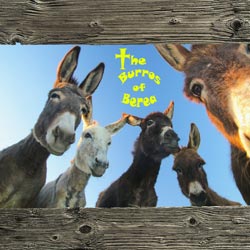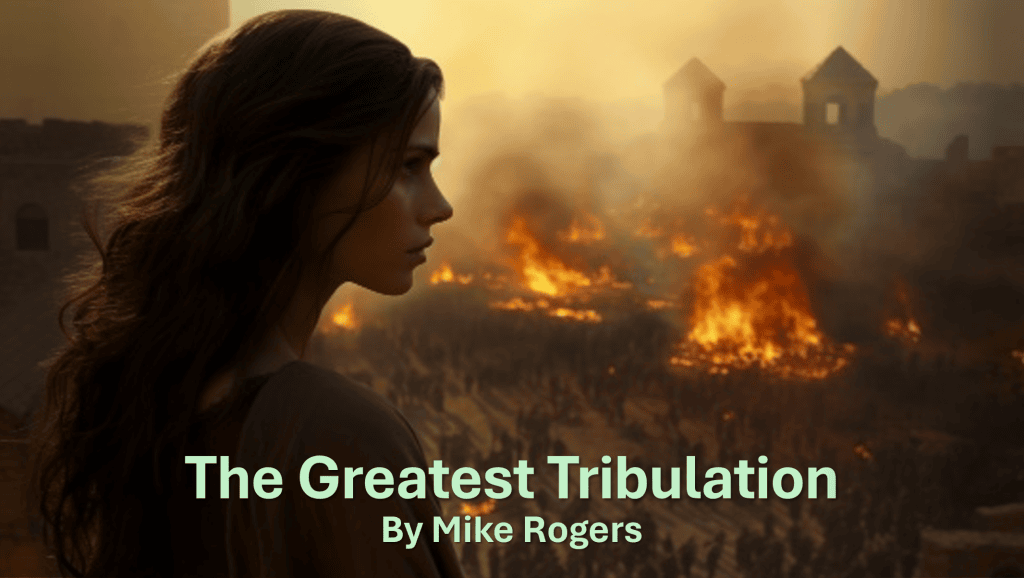Those who take Jesus’s words seriously understand that all of the things that He spoke of in Matthew 24 took place in that generation (Matt. 24:34), including the Great Tribulation (Matt. 24:34). The pop-prophecy pundits often object that this can’t be the case since the Roman-Jewish War was not the “greatest tribulation” ever.
That being said, I’m thankful to Mike Rogers for allowing me to share the following article from an ongoing series on his blogsite which can be found here: https://www.mikerogersad70.com/ .
Be sure to check out Mike’s book, Inmillennialism: Redefining the Last Days (https://www.amazon.com/Inmillennialism-Redefining-Last-Michael-Rogers/dp/1951252071). And stay tuned to The Burros of Berea (https://burrosofberea.com/) for an upcoming interview with Mike this fall.
The Greatest Tribulation
By Mike Rogers
Originally published on April 30, 2024
Jesus gives a second description of the “great tribulation” sign: it would be one “such as has not been since the beginning of the world until this time, no, nor ever shall be” (Matt 24:21). This begins the shift in literary styles that I mentioned earlier (here), from unadorned prose to figurative language, which heightens the effect of this and the remaining signs.[i]
Jesus describes the “great tribulation” using a literary device we now call hyperbole, where “more is said than is meant to be literally understood, in order to heighten the sense.”[ii] Such figures of speech may seem foreign to modern readers, but they were not strange to the disciples. The prophets often used these literary devices to describe God’s previous judgments of Israel and other nations. Writers in the apostles’ generation did as well. For example, Josephus,[iii] a Jewish writer who lived through the “great tribulation,” used similar language: “The multitude of those that perished exceeded all the destructions which either men or God ever brought upon the world.”[iv]
Neither the prophets, Jesus, nor Josephus, expected readers to understand these statements literally. They chose language that emphasized the gravity of what was to come.
Any attempt to interpret Jesus’ language literally creates difficulties. I will mention three. First, we don’t have a measuring system to gauge tribulation severity with scientific precision. There is no “suffering index” for afflictions, nothing equivalent to the Richter scale for earthquakes. Should we use the percentage of the population annihilated? If so, how could any tribulation exceed the great flood when the earth’s entire population perished except eight people?
Such questions and speculations seem juvenile because these writers never meant for us to ask them.
Second, interpreting hyperbole literally makes the Scriptures contradict themselves. Two events of the same nature cannot be the greatest of all time in any literal way.
With this in mind, consider Joel’s description of the day of the Lord in his near future:
Blow a trumpet in Zion; sound an alarm on my holy mountain! Let all the inhabitants of the land tremble, for the day of the LORD is coming; it is near, a day of darkness and gloom, a day of clouds and thick darkness! Like blackness there is spread upon the mountains a great and powerful people; their like has never been before, nor will be again after them through the years of all generations. (Joel 2:1–2 ESV)
Some commentators believe this prophecy referred to literal locusts.[v] If so, God would soon judge Israel by causing swarms of insects to invade the land. If this is Joel’s meaning, he contradicts Moses’ account of an earlier plague: “The locusts went up over all the land of Egypt and rested on all the territory of Egypt. They were very severe; previously there had been no such locusts as they, nor shall there be such after them” (Exod 10:14). Two locust plagues cannot both be the greatest of all time in a literal sense.
Other writers think Joel was speaking figuratively: his vision was about the soon-coming (to him) invasion of human forces. He was saying that a massive empire army, like locusts, would invade the land.[vi] If this is true, and if we should take him literally, Jesus now contradicts Joel because His “great tribulation” would result from invading armies (Luke 21:20) and would be the greatest of all time. Two invasions by human armies cannot be the greatest of all time in a literal sense.
We can expand the list of contradictions. Moses said to Pharaoh, “There shall be a great cry throughout all the land of Egypt, such as was not like it before, nor shall be like it again” (Exod 11:6). Insisting on a literal understanding of this language makes Jesus contradict Moses, for He said the “great tribulation” sign of the temple’s fall would be the greatest.
Who was the wisest man of all time, Solomon or Jesus? God said to Solomon, “I have given you a wise and understanding heart, so that there has not been anyone like you before you, nor shall any like you arise after you” (1 Kgs 3:12). But Jesus described himself as being “greater than Solomon” (Matt 12:42).
Who was the greatest king in Israel, Hezekiah, who “trusted in the LORD God of Israel, so that after him was none like him among all the kings of Judah, nor who were before him” (2 Kgs 18:5), or Josiah, of whom the Scriptures say that “before him there was no king like him … nor after him did any arise like him” (2 Kgs 23:25)?[vii]
In the Olivet Discourse, Jesus uses this well-established figure of speech to show that the “great tribulation” before the temple’s fall would be of the severest magnitude. He meant for his hyperbole to impress the disciples with the horrific nature of the coming event.
Recognizing the use of hyperbole in such passages removes the contradictions a literal reading would cause.
Third, a failure to recognize Jesus’ use of hyperbole disrupts the flow of Jesus’ prophetic statements. Modern interpreters who ignore the hyperbole in Matthew 24:21 think the tribulation associated with the temple’s fall could not be “the greatest of all time.” To bolster their case, they sometimes claim the Jewish holocaust in World War II was greater. This thought process leads them to believe that an even greater tribulation must be in our future, and it will be “the greatest of all time.” They place this ultimate tribulation at the end of the church age, just before the millennium or the eternal state.
However, if Jesus’ “great tribulation” sign pertains to this period, “it would be so trite as to be pointless to say that such distress would never again be equaled; of course it would never again be equaled, because Christ’s return will put an end to such a possibility!”[viii] Again, that such tribulation is never to be equaled implies that it cannot refer to the end of the church age, for if what happens next is the Millennium or the eternal state, it seems inane to say it will not take place again.[ix]
Recognizing hyperbole eliminates the need to place the “great tribulation” in a place that makes Jesus’ statement trite, pointless, or inane; it allows this sign to remain where He put it—just before the temple’s fall.
Jesus’ use of hyperbole to describe the “great tribulation” was fitting. Before the Romans destroyed the temple, they inflicted almost indescribable suffering on the Jews. Josephus provides an eyewitness account of the carnage. His summary contains language similar to that Jesus had used fifty years earlier:
It is therefore impossible to go distinctly over every instance of these men’s [the apostate Jews] iniquity. I shall therefore speak my mind here at once briefly:—That neither did any other city ever suffer such miseries, nor did any age ever breed a generation more fruitful in wickedness than this was, from the beginning of the world.[x]
Josephus was not a Christian and was not trying to support a prophetic framework. He certainly was not trying to verify Jesus’ prophecy of the “great tribulation.” Still, his hyperbole was necessary to convey the horror of what he saw. He and Jesus used this figure of speech to describe the suffering associated with the temple’s fall.
Conclusion
The closer Jesus’ signs were to the temple’s fall, the more elevated His language became. He used hyperbole to describe the “great tribulation” instead of the simple prose he used for the previous signs. We should not read his statements in a literal manner but should see them as a common way to stress the importance of what would happen.
Jesus’ next group of signs will contain literary devices that are even more impressive.
[i]. [note]This post is part of a series that began with The Great Commission and Biblical Prophecy: Introduction. After several posts and then a hiatus, the series began again here.[/note]
[ii]. [note]Ethelbert W. Bullinger, Figures of Speech Used in the Bible Explained and Illustrated (Grand Rapids: Baker, 1968), 423. Bullinger did not list Matt 24:21 as an example of hyperbole.[/note]
[iii]. [note]The image in this post is an imaginary woodcut engraving of Flavius Josephus in William Whiston’s translation of his works. It appears in an 1817 edition, so it is at least that old. It is in the public domain.[/note]
[iv]. [note]As cited by Milton S. Terry, Biblical Apocalyptics: A Study of the Most Notable Revelations of God and of Christ (1898; repr., Grand Rapids: Baker, 1988), 235; emphasis added.[/note]
[v]. [note]Robert H. Gundry, The Church and the Tribulation (Grand Rapids: Zondervan, 1973), 90.[/note]
[vi]. [note]Douglas Stuart, Hosea–Jonah, Word Biblical Commentary, vol. 31 (Dallas: Word, 2002), 250.[/note]
[vii]. [note]The examples here come primarily from John L. Bray, Matthew 24 Fulfilled, 5th ed. (Powder Springs, GA: American Vision, 2008), 93–94.[/note]
[viii]. [note]Craig L. Blomberg, “Matthew,” in Commentary on the New Testament Use of the Old Testament, eds. G. K. Beale and D. A. Carson (Grand Rapids: Baker Academic, 2007), 88; emphasis added. Blomberg thinks Christ’s parousia is a future point-in-time event, contra inmillennialism. His point about the timing of the great tribulation remains valid for my purposes.[/note]
[ix]. [note]D. A. Carson, “Matthew,” in The Expositor’s Bible Commentary, ed. Frank E. Gaebelein (Grand Rapids: Zondervan, 1984), 501.[/note]
[x]. [note]Flavius Josephus, The Works of Flavius Josephus, trans. William Whiston, 4 vols. (Grand Rapids: Baker, 1974), 1:404 (B.J. 5.442).[/note]

